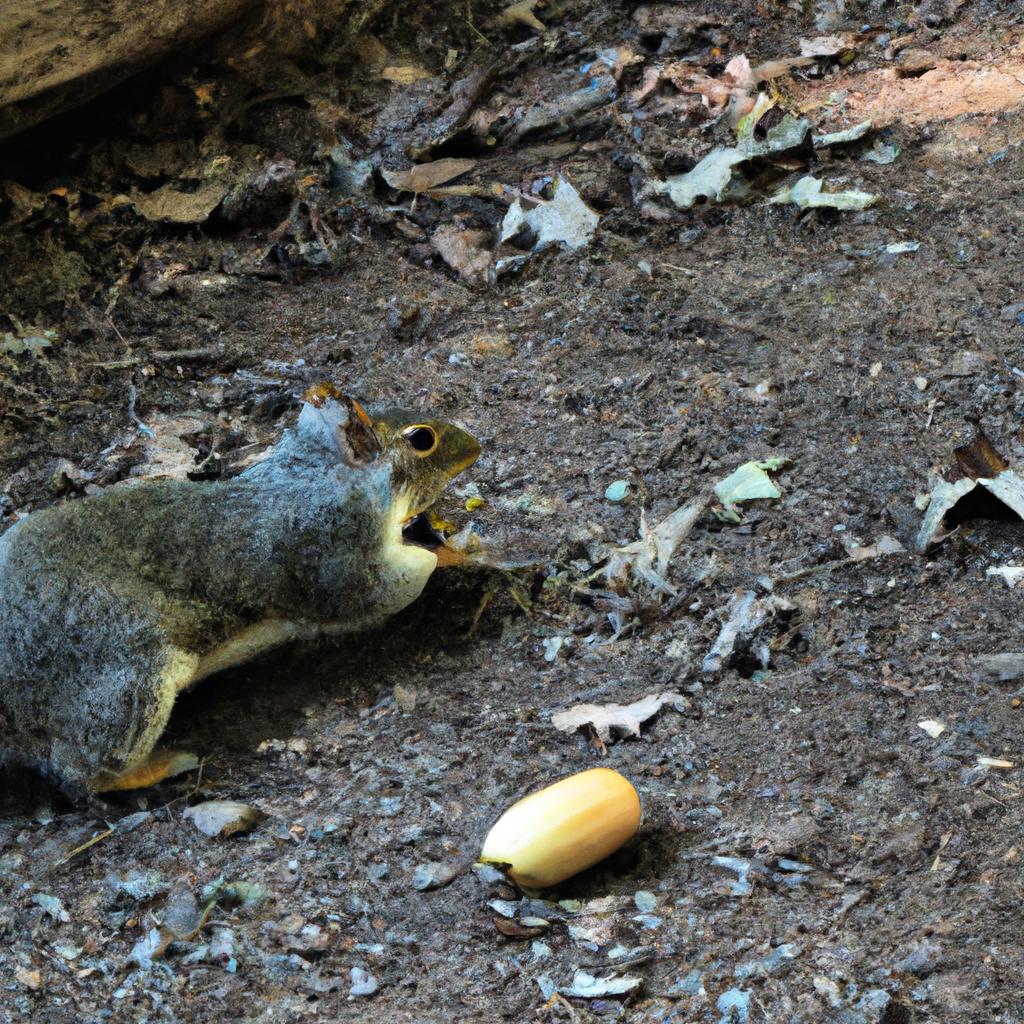As a backyard owner, I’ve always been intrigued by the various animals that visit my garden.
One of the most interesting critters I’ve encountered is the groundhog.
Also known as the woodchuck, this burrowing rodent is a common sight in many parts of North America.
Groundhogs are primarily herbivores, feeding on various plants, fruits, nuts and vegetables.
They have been known to eat acorns occasionally, but it is not a significant part of their diet.
In this post, I will delve deeper into the eating habits of groundhogs, specifically focusing on their relationship with acorns.
We will explore when, how, and why they eat acorns, and how often they do so.
We’ll also discuss the implications of this for backyard owners like myself and take a look at other animals that might eat acorns.
Contents
Groundhogs: A Brief Overview
Groundhogs, scientifically known as Marmota monax, belong to the rodent family and are closely related to squirrels.
They are primarily found in North America, particularly in areas with open fields, meadows, and woodlands.
These creatures are known for their burrowing habits, creating elaborate tunnel systems for shelter, food storage, and hibernation.
What Do Groundhogs Eat?
As mentioned earlier, groundhogs are primarily herbivores.
Their diet mainly comprises plants, such as grass, clover, and dandelions.
They also eat fruits, vegetables, and tree bark.
Some of the common food items found in a groundhog’s diet include:
- Lettuce
- Carrots
- Cabbage
- Apples
- Berries
- Tree bark
Acorns in a Groundhog’s Diet
Acorns, the nuts produced by oak trees, are a common food source for many animals. However, for groundhogs, acorns are not a significant part of their diet.

Groundhogs may eat acorns occasionally, especially if other food sources are scarce or unavailable. They may also eat acorns if they come across them while foraging for other food items.
It is important to note that groundhogs do not actively seek out acorns as a primary food source.
When Do Groundhogs Eat Acorns?
Groundhogs are most likely to eat acorns during late summer and early fall when acorns are abundant. This is also the period when groundhogs are preparing for hibernation, and they are actively foraging for food to build up fat reserves.
During this time, they will eat almost anything, including acorns, if they come across them while foraging.
How Do Groundhogs Eat Acorns?
Groundhogs have strong teeth that allow them to chew through the hard outer shells of acorns.
They will hold the acorn with their front paws and use their incisors to crack the shell, then extract and eat the nutritious inner part.
This process is similar to how squirrels eat acorns, albeit less efficient.
Why Do Groundhogs Eat Acorns?
As previously mentioned, groundhogs do not actively seek out acorns, and they are not a significant part of their diet. They will eat acorns occasionally, mainly out of convenience or necessity.
Acorns do provide nutritional benefits, such as protein, fats, and carbohydrates, which can help groundhogs build up their fat reserves before hibernation.
Implications for Backyard Owners
As a backyard owner, you may be concerned about groundhogs eating acorns, especially if you have oak trees on your property. However, since acorns are not a significant part of their diet, groundhogs are unlikely to cause any significant damage to your oak trees.
Instead, you should be more concerned about the other plants, fruits, and vegetables that groundhogs may feed on, as these are more likely to attract them to your backyard.
Other Animals That Eat Acorns
Acorns are a popular food source for many other animals, some of which include:
- Deer
- Squirrels
- Chipmunks
- Blue jays
- Woodpeckers
- Wild turkeys
These animals may also visit your backyard if you have oak trees, and they are more likely to cause damage by feeding on acorns than groundhogs.
How To Keep Groundhogs Out Of Your Yard!
There are several things that can be done to prevent groundhogs from digging and eating stuff in your backyard. I will list some of the strategies below.
Also, see my recent post if you want a full list of my favorite methods to keep groundhogs and gophers away!
1. Using ultrasonic sound
Groundhogs, like other bigger mammals that may invade your garden, tend to have very good hearing. This means that loud or consistent noises will scare them away or at least shorten their visits.
Check out my full buying guide for these ingenious ultrasonic repeller devices here!
One of my favorite technologies to keep pests away from my backyard is these cool solar-powered ultrasonic sound emitters that you can buy right from Amazon! In my experience, they really work, and the solar panels on top save you the time and money of changing batteries all the time.
They will also work against other rodents like gophers, mice, and rats!
2. Sprinkling natural repellents
Groundhogs may be scared off by using natural scents such as coyote urine or predator scents.
They may also cause them to leave if there is a combination of sounds being played from a radio. The sounds include the sound of barking dogs and coyotes.
You can sprinkle dog hair, cayenne pepper or strong enteric oils and other natural repellents around the garden to keep the groundhogs away.
See my complete list of humane ways to keep groundhogs away from your yard for more tips and tricks!
3. Fencing around the garden
You can also fence around your garden to keep groundhogs from entering the garden. It should be at least 3 feet deep and have a double row of fencing.
Groundhogs are good diggers so it has to go underground or they may find a way into the garden even with the fences in place!
4. Using live traps
You can use a live trap to capture groundhogs and move them to another area. Live trapping is currently the most humane way of groundhog control. Once you have removed all groundhogs from an area, it is important to ensure that they do not come back by using fencing or other barriers to block access.
You can also just buy a live trap, as the sturdy metal ones shown here:
To lure the groundhogs in, you can use one of the numerous favorite foods of groundhogs or an optimized extra attractive formula like this one to make the catch even quicker!
5. Using natural pesticides
There are pesticides or rodent toxins that can be used to kill groundhogs on your property. These may also affect other animals in the area so it is important to ensure that they are only sprayed on the targeted plants.
I do not recommend these, as I prefer more humane ways as described here. Also, anything that kills an animal will also harm humans to some degree, so go for a repellant rather than a toxin if you go the chemical route!
6. Using Scarecrows
You can use a scarecrow in your garden to keep groundhogs away. Groundhogs are afraid of novelty so time-sensitive or motion-activated scarecrows may also be effective in keeping them out of the garden.
7. Using Lights
Groundhogs are not strictly nocturnal animals but they are most active at low light so they do avoid areas with bright lights.
Motion-activated lights, sounds, and sprinklers may help prevent groundhogs from entering your yard.
Any blinking light will confuse and scare away groundhogs from your yard, especially if they are motion activated and sudden!
8. Motion-activated sprinklers
Like most animals, groundhogs hate surprises, and they will run away if suddenly sprayed with water. I like this solution because it is humane, simple, effective, and does not require much time to set up.
The Havahart 5277 is a motion-activated sprinkler that is activated by the movement of animals up to 25 feet away and sprays them with a harmless water jet, frightening them off and keeping them at bay.
The included metal stake makes it easy to install in your garden, and the sprinkler can be rotated 180 degrees for maximum coverage.
## Conclusion
In conclusion, while groundhogs do eat acorns occasionally, it is not a significant part of their diet. They are more likely to feed on other plants, fruits, and vegetables found in your backyard.
As a backyard owner, you should be more concerned about these other food sources, as they are more likely to attract groundhogs and other animals that feed on acorns. By understanding the eating habits of groundhogs and other animals, you can better protect your backyard and its inhabitants.
















